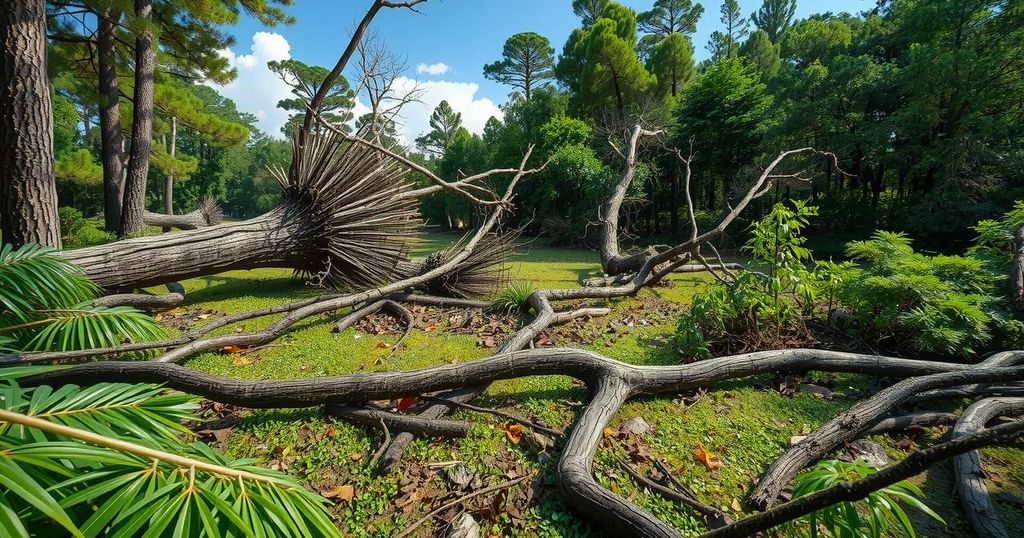Hurricane Helene and Its Lasting Impact on Wildfire Risks
Hurricane Helene’s aftermath may increase wildfire risks in the Southeast U.S. due to downed vegetation. Experts emphasize the dual role of fire in ecosystems while advising homeowners on preventive measures. Colorado State University forecasts an above-average hurricane season in 2025 with 17 named storms, highlighting the ongoing need for awareness and preparedness.
Last fall, Hurricane Helene caused significant devastation in Southwest Virginia, Northeast Tennessee, and Western North Carolina. Communities continue to recover months later, as the effects of the storm linger. Experts believe that the downed debris from Hurricane Helene may exacerbate the risk of wildfires in the region during its typical wildfire season.
Michele Steinberg, Wildfire Division Director at the National Fire Protection Association, seeks to educate about the dual nature of fire within ecosystems. “Fire on the landscape does all kinds of beneficial things like returning nutrients to the soil,” she explains. Seasonal wildfires provide ecological benefits by eliminating dead vegetation, thus promoting the growth of particular species.
In the Northeast, Mid-Atlantic, and Southern states, conditions are ripe for wildfires during spring and fall. Steinberg warns that even when snow is present, dried vegetation can ignite, particularly on sunny days with strong winds. “If you have a nice, sunny day, you get a lot of solar heating to the ground,” she notes, elaborating on the necessary fire triangle of fuel, heat, and oxygen.
Trees, grasses, and shrubs naturally serve as fuel for fires. However, wildfires impacting communities can turn homes and vehicles into combustible materials. Steinberg cautions that post-storm debris can significantly increase the risk, as fallen trees and shrubs create a hazardous fuel load: “You’ve got all this stuff that’s hard to move. The material is dead now or dying – it’s drying out.”
The aftermath of hurricanes like Helene presents logistical challenges for fire services attempting to manage wildfires. Crews must first prioritize restoring infrastructure and access routes, which may hinder their capacity to address emerging fire threats. Steinberg states that communities alerted emergency personnel soon after Helene to the potential for increased wildfire risk due to downed vegetation.
Moreover, she recommends that residents equip themselves with knowledge regarding wildfire conditions and alerts, such as the “Red Flag Warning” issued by weather services. “Those are the three big ingredients that if you have fuel and an ignition, you’re likely to have a major fire start and spread quickly – and that’s what people need to be hyper aware of,” emphasizes Steinberg.
Homeowners can take practical steps to mitigate risks, particularly by ensuring that the vicinity of their property is clear of combustible materials. By removing leaves and debris around homes, the risk of embers igniting nearby structures during a fire can be substantially reduced. The National Fire Protection Association provides resources and guidance for communities participating in the Firewise USA program.
In a related forecast, Colorado State University has projected that the Atlantic hurricane season for 2025 will feature 17 named storms, exceeding historical averages. The report anticipates that nine storms will be hurricanes, with four classified as major hurricanes. Levi Silvers cites the warm sea-surface temperatures and the current weak La Niña event as contributing factors to this prediction.
The Atlantic hurricane season is set to run from June 1st through November 30th each year, emphasizing the importance of preparedness as residents contend with both hurricane and wildfire risks.
In summary, Hurricane Helene’s aftermath poses an elevated risk for wildfires due to the increased fuel load from downed vegetation and debris. Homeowners and communities must remain vigilant, understanding the conditions conducive to wildfires while taking preventive measures. Additionally, the projection of an above-average Atlantic hurricane season underscores the need for preparedness as natural disasters can have compounding effects on communities already affected by previous storms.
Original Source: www.wvtf.org




Post Comment